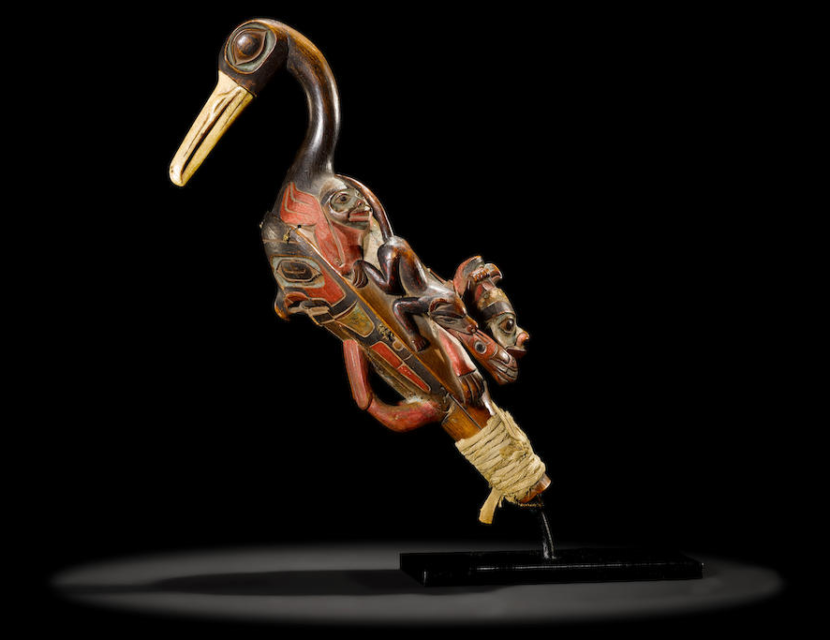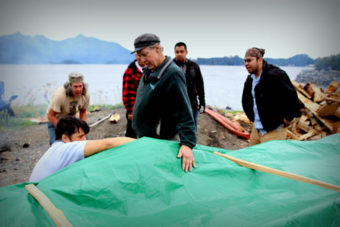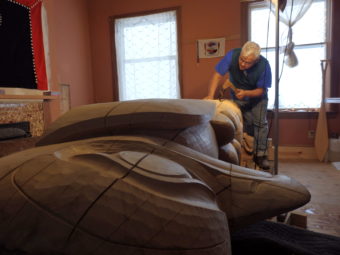
A rare wooden rattle attributed to a famous Tlingit artist sold at an art auction in California last month. The 230-year-old piece came from a private collector and sold for over half a million dollars.
When Sealaska Heritage Institute’s Native arts curator Steve Brown first laid eyes on the shaman’s rattle, he was amazed by the piece’s excellent condition.
“Nobody had ever seen this before,” Brown said. “It had just kind of come out of the woodwork.”
The rattle came from a private collector who was trying to sell it. Representatives from Bonhams, an international art auction house, contacted Brown to identify the rattle’s origins. Brown determined it was the work of a woodcarver named Kadjisdu.axch, who lived in a village near modern-day Wrangell 200 years ago.
The artist has been described as the greatest carver of wood in the history of the Tlingit people.
Haines master carver Wayne Price teaches Northwest Coast design and carving at the University of Alaska Southeast. He said that Kadjisdu.axch has had a profound influence on carving in Southeast Alaska.

“He didn’t let anything interfere with what he was trying to say with his woodwork. He pushed the most absolute expression of the wood in that particular spot to express his idea,” Price said.
Price and Brown immersed themselves in the work of Kadjisdu.axch while making replicas of a set of house posts that he carved for Chief Shakes in Wrangell.
These house posts, as well as the Whale House posts in Klukwan, are among the carver’s most well-known creations.
According to Brown, there are roughly 20 known pieces that have been attributed to Kadjisdu.axch, but it can be difficult to identify his work with certainty.
“No traditional Native artists on the Northwest Coast signed their work. That was important. It wasn’t about the artist. It was about the clan leaders and the people for whom the art was made,” Brown said.
The rattle sold at the auction last month depicts an oystercatcher with several other creatures incorporated into the design.
There are several characteristics of the rattle that can be linked to the house posts that Kadjisdu.axch carved. Brown points to similarities in the two-dimensional design work.
The rattle’s asymmetry showcases the artist’s unique style as well.
“On one side of it, there’s this salmon. The head of it is in the mouth of the bear. Coming around the side of the rattle, as if it wasn’t even meant to be there — like it just crashed the party — is this little wolf figure that looks like he just walked around the side of the rattle and grabbed the tail of the fish,” Brown said.
Kadjisdu.axch’s carvings have been the subject of controversy in the past. In 1984, the house posts he carved in Klukwan were removed from the Whale House and sold to an art dealer in Seattle. The house posts were returned to the village following a tribal court case and are currently on display in the Jilkaat Kwaan Cultural Heritage & Bald Eagle Preserve Visitor Center.

When asked how he feels about the rattle’s sale by a private collector in the Lower 48, Brown said he understands the tendency to lament Native artwork that has been taken away from Southeast Alaska.
“But on the other hand, when things have been preserved in museums and even private collections, they’re available to educate people about the historical art traditions so that people, in general, can gain a respect and understanding of what these obscure tribal traditions were and have a greater respect for the people involved,” Brown said.
Price said he has his own opinions about the sale of Native art, but he’s more concerned about teaching the next great carver.
“I can’t change what’s already been done. But I can train students and show them this kind of work,” Price said. “I hope that it’s brought out in a place that people will be able to visit it and see it. If you know about wood then you have a lot to learn by being in the presence of such a great piece.”
Representatives from the Bonhams auction house were unavailable to comment for this story. No information has been released about the seller or the buyer. At this point, it’s unclear what will happen to the rattle.
